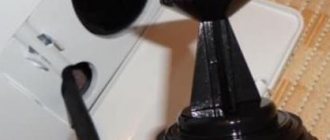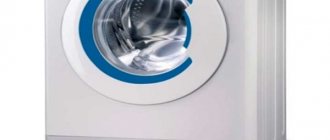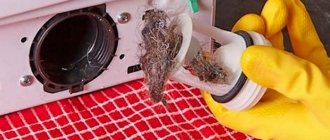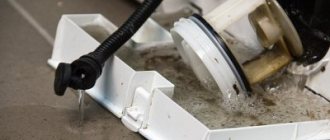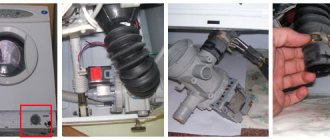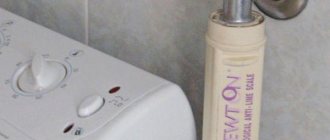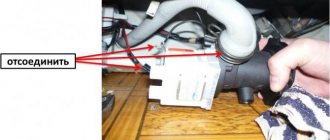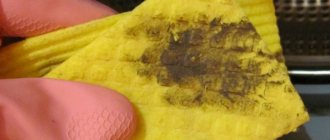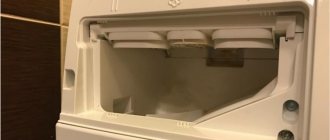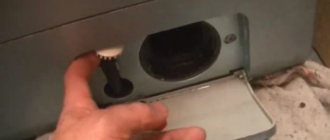Let's look at how to clean the filter in a washing machine of any brand. Clogging is a common problem that can cause your washing machine to perform poorly or stop working. Not every user knows that you can easily deal with the problem yourself, and not call a specialist, continuing to pay him for such an easy job...
- Causes of blockage
- Where is the drain filter located?
- How to clean SMA of different brands - step-by-step instructions
- Frequency of prevention
- What happens if the filter is not cleaned?
- If it doesn't unscrew
- If the filter is leaking
- Catalog of washing machines with reviews
Causes of blockage
Blockages are divided into two types: mechanical and natural.
Washer drain filter
Mechanical failure occurs due to foreign objects entering the filtration system. Most often these are small, hard items that were forgotten in clothing pockets while loading laundry. Among them you can find:
- coins;
- toothpicks;
- zippers or buttons that have come off during washing;
- fasteners or bones from women's underwear;
- small toys (from the same “Kinder Surprises” or keychains);
- and anything else that may have remained in your pockets or come off your clothes.
Expert opinion
I work in the household appliance repair industry. Extensive experience in restoring washing machines and dishwashers.
Ask a Question
Such items gradually accumulate in the washing machine, which will later cause it to block.
The natural type of blockage does not appear as quickly as the mechanical one. And if the second one can appear by simple accident or inattention, then the blockage that occurs naturally is, in some way, inevitable. Gradually, small fluff, wool, hair, particles of cotton wool or fluff accumulate - everything that was on the clothes during washing.
Reasons for clogged filters
The main factors of contamination of filter systems are:
- rust and its detachments. The filter rusts due to constant contact with tap water. It is required to check its condition once every 3 months - so the permeability and quality of water inflow will remain unchanged;
- lime deposits. When the filter and waste water come into contact, evaporated salts and minerals settle on the part;
- small elements. During washing, wool, hair, fasteners, sand and debris are washed out of clothes. Timely removal of the blockage will prevent clogging of the filter and ensure that the machine can drain the filter.
Important! In hard water, lime deposits form on the filter faster.
Online diagnostics of a washing machine
If your machine stops washing or rinsing clothes normally, then some kind of malfunction or breakdown has occurred.
You can try to find the problem yourself. Run diagnostics
Select which operation your washing machine does not perform:
1. Doesn’t drain 2. Doesn’t rotate the drum 3. Doesn’t spin clothes 4. Noises, knocks, buzzes when spinning 5. Doesn’t turn on
Checking the operation of the drain pump Is the drain pump of the washing machine working? Yes No I don’t know << Back
Clogged hoses in the washing machine If the sound corresponds to the normal sound that has always been observed when the device is working, the cause is probably a clog.
Was there a blockage in the drain hose? Yes
<< Back
The drain pump does not work! If the sound matches the normal sound of the drain pump, it is recommended that you check the drain filter first.
After cleaning, does the drain pump work and does the washing machine drain water? Not really
<< Back
Operation of the drain pump The sound of the pump is usually immediately audible and noticeable. If there is no sound, the pump is not working. We are looking for how to separately enable the water drainage program. As a rule, this is a separate option. After the program has been turned on, the pump should start working in 1-3 seconds. If everything is done correctly and the pump is operational, a buzzing sound will appear. If you hear no buzzing or other sounds when you turn on the program, the pump is probably faulty.
Is the washing machine drain pump working? Not really
<< Back
Clogged car hoses If you have identified a clog in the hoses, you need to disassemble them, clean them, and then reassemble everything.
Does the washing machine drain well? Not really
<< Back
Hurray, you did a great job, you fixed it.
<< Return to the beginning of diagnostics
The drain pump is faulty, call a professional.
<< Return to the beginning of the diagnosis.
The washing machine does not rotate the drum. During the operation of the washing machine, such a problem may occur. Each model has a different drum operation. It rotates according to a given algorithm, which is set by the program. This principle applies to spinning and washing. If you are not sure whether the drum is not spinning or whether it is working, put the laundry in the washing machine. Start the spin program. If the machine is running, it will first drain the water and then start spinning. In this case, a rotational process will be observed. If rotation is not visible, then check the belt. First, turn off the program, then unplug the wire from the outlet so that power does not flow into the device. Now you need to remove the back cover. You will need to carefully inspect the drum belt. It is quite easy to determine whether it is in the wrong position or damaged.
Is the washing machine belt torn or stretched? Not really
<< Back
Broken drum drive belt If the belt breaks, it will be immediately visible. There are also often cases when the belt simply stretches, which is why the drum, accordingly, does not rotate. Do not allow the machine to operate if the belt breaks. It is important to check whether it has wound around the engine pulley or broken the wiring to the engine. The heating element and temperature sensor may also be damaged if the belt does catch the wires. It is imperative to ensure that the belt model is original. If you choose an unsuitable or low-quality product, this will affect the performance of other devices. How do you know what kind of belt you have? There will be a marking written on the old one, compare it with the one indicated on the belt offered to you. You can also find out belt information by car model.
<< Return to the beginning of the diagnosis.
Washing machine motor malfunction If a malfunction is not found, the block with wires must be disconnected from the electric motor. Carefully remove it. We visually evaluate the engine. It may have melting, cracks, or other effects that clearly indicate damage. We call the windings of the tachogenerator and the engine. It is important to understand that you can fully study how correctly the engine operates and whether there is a malfunction only at the stand. If rotation does not occur, there may be a problem with more than just the motor. Sometimes the cause is a malfunctioning electronic module. If a short circuit occurs in the engine, the module could be damaged, while the engine remains operational. Also, the wires could be damaged.
<< Return to the beginning of the diagnosis.
Repairing a washing machine that does not spin clothes After completing the washing process, the washing machine may not spin properly or may not start spinning. Firstly, look, perhaps another mode is set, which does not involve turning on the spin cycle at all. This happens, for example, with programs related to washing woolen items and delicate fabrics. To check, run the spin cycle separately. If the washing machine does not drain water, we proceed to check the pump.
Does the washing machine now spin clothes? Not really
<< Back
Congratulations, you have solved your problem!
<< Return to the beginning of the diagnosis.
Repair of washing machines, imbalance Modern washing machines place the laundry on the drum before spinning. This is necessary for quality work. Check if this feature works. Sometimes a situation occurs when things get wrapped up in a ball that cannot be unwound automatically within a certain time. At this point the work stops. You need to unwind this laundry yourself, lay it out and continue operating the washing machine. In this case, it is important to turn off the machine, and then, when the laundry is laid out, turn on a separate spin program.
Does the washing machine now spin clothes? Not really
<< Back
Washing machine repair, drum drive repair Now you need to check the drum drive belt. We remove the cover and visually assess the condition of the belt. There should be no damage. If the tension is weak, the spin may not turn on. If you need to replace the belt, you should only replace it with the original one. After replacing, we try the program again.
Fault found, does the washing machine spin? Not really
<< Back
The engine or electronic module is faulty, call a repairman to your home.
<< Return to the beginning of the diagnosis.
The washing machine hums, makes noise during the spin cycle, rumbles, and makes a jet plane noise. If the washing machine makes noise during operation, making unusual sounds, it’s time to pay special attention to it. In this case, a visible breakdown or lack of functionality may not be observed, but the appearance of strange sounds indicates that it is time to look for a malfunction. It is important to understand that a new car that has just been delivered should be inspected for shipping bolts. If you forget to remove them, noise and vibration are inevitable. So, let's begin! We turn the washing machine drum and listen to extraneous sounds.
When rotating, do you hear extraneous noise, hum, balls rolling, does the drum move unevenly with slight jamming? Not really
<< Back
If the drum rotates and uncharacteristic sounds appear, including vibration, it’s time to check the bearings. If they malfunction, they will have to be replaced.
<< Return to the beginning of the diagnosis.
The counterweight of the washing machine has come loose. The fastening of the counterweights must also be of high quality. If they are “loose”, it’s time to eliminate this defect. In some cases, you can notice that the bolts that secure the stones are completely missing. In this case, the connectors for mounting will be visible. The bolts need to be found and put in place - they probably simply came loose. A rumble heard while the washing machine is operating may indicate that the bolts have partially loosened. To check the bolts, you can simply push the drum. If it is secure, the bolts are fine. If it moves, there is a defect.
Do you hear any noise, clanging or rattling noises when moving the washing machine tub? Not really
<< Back
The counterweight has come off
<< Return to the beginning of diagnostics
Checking the shock absorbers of the washing machine Checking the shock absorbers. If you hear vibration or excessive noise during the spin cycle, there may be a problem with the shock absorbers. Sometimes the washer moves. Now let's check the functionality. Remove the top cover. Click on the tank, move it five to seven centimeters down. A normal reaction will be observed if the tank rises sharply, jumping a little and stopping in its normal place. If this does not happen, the shock absorbers need to be replaced.
Are the shock absorbers of the washing machine working? Not really
<< Back
If a visible defect has not been identified, check whether a foreign object may have entered the machine. Replacing shock absorbers. The problem with shock absorbers wearing out occurs quite often over time.
<< Return to the beginning of the diagnosis.
Replacing washing machine shock absorbers. Malfunction and wear of shock absorbers is a fairly common phenomenon.
<< Return to the beginning of the diagnosis.
The washing machine does not turn on. It is worth trying to find the cause of the problem yourself and fix it. We start by connecting the device to the network. Next, click on the “network” button. In different car models, different indications are triggered: here either the display will start working, or, on the contrary, some other button.
Does the washing machine have an indicator? Not really
<< Back
Hatch lock lock (UBL) You can check it by turning on any of the programs. We choose what we will use. Click on the corresponding button. Don't forget to pay attention to the inclusion. As a rule, the process of activating a function is characterized by the presence of a certain sound, for example a click, with which the device makes it clear that pressing again is not necessary and the machine is already working. If there is no sound, the button may be broken. In this case, the main thing that must be done is to block the hatch and start working. If this happens, everything is fine.
The washing machine is blocking the hatch and the UBL is triggered? Not really
<< Back
Water fill valve malfunction
<< Return to the beginning of the diagnosis.
The washing machine hatch does not lock
<< Return to the beginning of the diagnosis.
No indication Checking the electrical circuit. If you notice that the washing machine does not respond to being turned on, it is first recommended to check the power supply. The outlet may be faulty. Try connecting another device. If the outlet works, you need to check whether the circuit that conducts energy through the washing machine from one element to another is intact. To do this, you will need a multimeter, which will help you fully analyze the ability to respond to an electrical signal at several stages of operation. If there is no network connection anywhere, this is probably the problem. We carry out this manipulation until we reach the electronic module. If we are talking about an old washing machine, here it will look like the device’s program. When you turn on the button, there should be no breaks in the circuit. If the circuit works, everything is fine electrically.
Is the washing machine's power supply OK? Not really
<< Back
Repair of electronic module (unit)
<< Return to the beginning of diagnostics
Contact circuit fault
<< Return to the beginning of diagnostics
Troubleshooting Yourself
Initially, you should check whether the washing mode is selected correctly. Every Beko washing machine has a cycle that washes delicate fabrics and woollens without spinning. If it is installed, then after washing, you must separately start the process of draining the water. To do this, press the “Start” or “Start” key.
You also need to check whether the drain hose is connected to the machine correctly and assess its condition. If it is too bent or pinched, the water will not drain. In addition, the hose may be clogged with debris. In this case, you should clean it. The length of the drain hose plays an important role when draining water. If a hose longer than 1.5 m is installed, the pump will not be able to pump water over a long distance.
Also, the machine may not drain water due to a clogged filter. In Beko washing machines, the filter is located behind a small protective panel on the right side. You need to remove the filter by turning the holder to the right. Prepare a basin in advance, because water also accumulates in the filter compartment. Afterwards, the garbage disposal must be cleaned and rinsed under the tap.
When using the machine for a long time, the drain pipe also needs to be cleaned. You can get to it from the bottom of the machine, armed with a screwdriver. The pipe is held on by three fasteners that need to be loosened. Having separated the part, we clean it with a small brush, and then install it back. If you find cracks or holes in the drain pipe, it must be replaced with a new one.
Article on the topic: Can an angora cardigan be washed in a washing machine?
To prevent washing machine maintenance, you can also clean the filter installed on the water supply. You can find it on the back panel of the machine, where the hose is attached. Cleaning it prevents the accumulation of sand and rust from tap water.
There is also a drain pump on the back of the washing machine. If the machine hums strangely when washing and refuses to drain the water, then you should pay attention to it. Beko washing machines are equipped with a self-diagnosis function and often detect a breakdown of the pump in the pump responsible for draining the water. And the lit H5 key on the control panel notifies you of this. However, in case of minor failures, the controller does not respond. For example, the impeller in a pump may become loose and fall off, which can be detected by a humming sound.
To check the pump, you need to turn on the water drain mode and evaluate the reaction of the impeller. If it does not rotate, then the pump needs to be cleaned or replaced.
Where is the drain filter located?
Most often it is located on the outer panel at the very bottom right or left. Let's take a closer look at the options for its location for each brand.
- “Indesit” and “Ariston” - the filter is located under the lower removable panel, on the right.
- "Bosch" and "Siemens" - located in the lower anterior part of the MCA, on the right. In order to access the filter, you need to open the false panel.
- "Samsung", "Atlant" and "Haier" - located low on the front bar, also hidden behind the hatch.
- “LGi” - like Samsung, on the front panel of the device, below, but on the left under the false panel.
- "Beko" - below, on the right under the removable bar.
- “Burning” and “Candy” are on the front part, below, behind the hatch.
- “Zanussi” and “Electrolux” - things are loaded into the machine vertically, so it is located in the edge of the drum.
- "Whirlpool" - in the lower left corner of the case.
Expert opinion
I work in the household appliance repair industry. Extensive experience in restoring washing machines and dishwashers.
Ask a Question
Important! Some washing machines do not have it! These are either compact models under the sink or with top loading.
Pump filter location
Information about filter types
Conscientious manufacturers of modern washing machines install two filters in washing machines:
- The first is the inlet valve cleaning filter;
- The second is a drain or drain filter.
Such filters are supplied by manufacturers of both expensive equipment (Siemens, AEG) and more affordable ones (Candy, LG, Whirpool, Indesit).
The inlet filter is a mesh on the inlet water supply hose. It prevents metal particles, sand, rust and other debris from entering the machine from tap water.
The presence of a drainage filter protects the drain pump from the possible entry of small items of clothing into it: buttons, fasteners, pins, and threads. Their accumulation in the drain hose or in the pump can lead to larger equipment malfunctions. It is usually located at the bottom of the front panel or on its lower wall and is closed from the outside with a hatch.
But how do you know when it's time to clean the filter? You should suspect a similar problem if water at normal pressure begins to fill too slowly or the device drains it very slowly. There are situations when water does not flow into or out of the machine at all.
How to clean SMA of different brands - step-by-step instructions
Indesit
You need to unplug the device from the outlet, move it to the wall and place it in such a position that there is some distance between the bottom of the machine and the floor. You will need it in order to later place a basin or bucket under the drain when water flows from there. Now, using a knife or screwdriver, move the bottom panel away, prying it up a little. Let's put it aside.
The bar covering the filter of the Indesit SMA
There will be a filter at the bottom right. We unscrew it counterclockwise, first placing a water container or a regular floor rag under it. After all the liquid has poured out, you should check the inside of the filter for the presence of foreign objects. Clean the concentrator itself and its container.
We twist it clockwise, put the panel back, return the SMA to its place and connect it to the network.
Ariston
Unplug the device from the outlet. Moving the machine to the side, lean the upper part on the wall so that in the future it will be convenient to get to the filter. Remove the protective panel at the bottom of the case on the front of the device. Take a bucket and any smaller water container. Place it under the filter, then start unscrewing it counterclockwise, but not completely, otherwise everything will flood.
As the container fills, continue unscrewing and tightening the filter. Drain the water into a large bucket. When all the liquid is gone, remove the foreign objects. Screw on the filter and cover it with the panel. Place the machine in its rightful place.
Hotpoint-Ariston CAWD 129
Bosch
As before, unplug the machine from the outlet and place it in a comfortable position. There is a panel at the bottom right that needs to be opened and set aside. You should prepare floor rags and water containers in advance. First, carefully remove the hose, which is located to the left of the filter. After unscrewing it, wait until the water drains, then put it back in its original place.
We do the same with the filter. Peel and screw it. Close the device with the panel and place it in its original place, plugging the washing machine into the outlet.
Location of the concentrator on an old Bosch washing machine
Siemens
Prepare a floor cloth so that the water can drain onto it. At the bottom right there is a panel that must be removed to freely access the filter. Place a rag under this area and begin to unscrew the cap counterclockwise. Wait until all the water has drained.
After this, remove the filter, rinse, and get rid of foreign objects. Screw the cover clockwise and place the panel.
Siemens is doing great
Samsung
Unplug the machine. Use a screwdriver or knife to pry up and remove the panel located in the lower right corner of the front side of the machine. Open the hose located to the right of the filter to drain the water from it. Tighten the hose and put it in place. Now take out the filter, drain the water, clean it. Put it back and cover it with the panel.
At Samsung SMA, the pump is always on the right
LG
Turn off your device. Open the protective strip located at the bottom right. Unscrew the tube and drain the water. After that, put it back and open the filter. After removing foreign objects and washing, put it back, closing the protective panel.
LG always uses a cover
Beko
You need to unplug the device from the outlet, move it to the wall and place it on the “back legs” of the machine. Using a knife or screwdriver, remove the bottom panel. We unscrew the filter counterclockwise, first placing a container or a regular floor rag under it. Wait until all the water has drained out.
Clean the concentrator and its container from foreign objects and dirt. We tighten the filter, put the panel back, return the washing machine to its position and plug it into the outlet.
Beko can have it on the left or on the right
Gorenje
There is a panel at the bottom right that needs to be removed. Place a rag under this filter and start unscrewing it. Wait until all the water has drained. Remove the item, rinse it, get rid of any debris. Screw the cap clockwise and close the panel.
Gorenje is always original
Candy
Place a rag under the hatch located on the left, at the bottom of the machine. Open the hatch. Unscrew the filter. Drain off all the water. Wash the filter and its internal parts. Place the item in place by tightening it. Close the hatch. Get rid of water in the room.
Atlant
Use a screwdriver to remove the bottom panel. We unscrew the filter counterclockwise, first placing a container under it. Wait for the water to flow out. Clean the concentrator and its container from foreign objects and dirt. We tighten the filter, put the panel back, return the washing machine and plug it into the outlet.
Do you wash by hand?
Oh yes! No
Zanussi
This is a machine with a vertical form of loading laundry. To get to the filter, open the lid, and then the drum itself. There is a cap at the bottom that will need to be removed. After that, we take out the filter itself, clean it of various debris, rinse it and put it back.
Electrolux
At the bottom of the machine in the right corner under the cover there is a filter and a hose. First you need to drain all the water, and then unscrew the concentrator. After cleaning the filter, return it, as well as the hose, to their original places, closing the protective panel.
Electrolux always has a hatch
Whirlpool
In the lower left corner of the machine there is a protective bar in the form of a window. Open it to see the filter itself. Having placed a cloth on the floor, we begin to unscrew the concentrator and wait until all the water has drained into the cloth. After this, remove the filter completely. Having cleaned and washed it, we return it to its original place, closing the panel.
The Whirlpool concentrator is closed with a bar at the bottom
Haier
Unplug the machine. Using a screwdriver or knife, remove the bar located in the lower right corner of the front side of the machine. Open the hose located to the right of the filter to drain the water from it. Tighten the hose and put it in place. Now open the concentrator, drain the water, clean it. Place the filter in place and cover it with the panel.
Types of pollution and factors causing them
Before cleaning the filters, it is necessary to determine the type of contamination and the reasons for its occurrence. To prevent the formation of dirt, there are preventive methods and means. Knowing the causes, consequences and ways to eliminate the problem, you will extend the life of your machine and ensure its trouble-free operation.
In addition to the usual garbage that gets into the washing machine along with things, ordinary dirt, limescale, scale and mold deposits can be considered as filter contaminants. There are different methods and available means to eliminate them. With their help, you will not only clean the filters, but also prevent the appearance of contaminants.
The reasons for filter contamination are:
- hard water;
- particles, lint, separated from washed items;
- untimely cleaning and drying of all machine elements;
- poor quality of powders and other detergents.
Let's look at the main types of pollutants and ways to eliminate them.
Poor quality water becomes one of the main reasons for the formation of scale and limescale on filters and other machine parts. Professional and home remedies can be used to clean the washing machine.
Acetic or citric acid and soda can be used as improvised cleaners. These are excellent car cleaning products that every housewife has on hand.
Professional tools are selected in accordance with the functional features of the device and your financial capabilities.
Whiteness is considered a simple and affordable remedy. Cleaning can also be done mechanically, but not independently, but with the help of specialists who use special devices for these purposes.
When dirt, lint from clothing gets on the filter, as well as when cleaning is not done in a timely manner and low-quality laundry detergents are used, deposits of dirt, mold and an unpleasant odor are formed. Cleaning is carried out, as in the first case, with home and professional means.
A qualified plumber can help you determine the causes of filter contamination. It can also tell you which cleaning methods are most effective.
In addition to vinegar and citric acid, it is recommended to use copper sulfate and soda, as well as whiteness. After cleaning and finishing the rinsing cycle, all parts must be wiped with a clean, dry cloth and dried.
What happens if the filter is not cleaned?
If you ignore the problem of a dirty concentrator in a washing machine, then many problems will arise when working with it. Due to contamination of the filter, the water in the device may not drain; an error may appear on the display, making further washing impossible. Limescale, rust - all these are the consequences of ignoring this problem, which in the future can lead to the final breakdown of the washing machine.
Expert opinion
I work in the household appliance repair industry. Extensive experience in restoring washing machines and dishwashers.
Ask a Question
Important! In vertical loading, this leads to more serious consequences. Due to the blockage, the laundry is spun with water in the drum. But the design of these devices is such that the top of the tank is not completely waterproof. As a result, drops of water burst out and flow down the surface of the tank. They get on the engine. This leads to its damage. In the worst case, the electronic module also burns out. In this situation, it is cheaper to buy a new washing machine.
Pollution prevention
Every owner of washing machines needs to remember that only the use of preventive measures coupled with regular inspections can extend the life of household appliances. Need to:
- Soften the liquid. The harder the water resource, the faster scale accumulates. We recommend installing a special filtration system when connecting water supply (well or centralized) to the house. The kit should contain not only devices for coarse and fine water treatment, but also softeners. You can order such equipment at.
- Open the drain filter and clean it regularly. At least once every 6 months, but more often is better.
- Inspect laundry before placing it in the drum. Remove all trash from pockets. Use special covers for washing some clothes.
- It is worth “running” the machine with citric acid every 2-3 months.
If it doesn't unscrew
If for some reason the filter does not unscrew, cannot be pulled out, or some problems arise with this, then it is better to call a specialist. If you use too much force, you can damage the inside of the filter, deforming it. This leads to further leakage of the concentrator and deterioration of its overall performance.
The problem occurs due to scale deposits. Partial disassembly of the washing machine and removal of the drain pump will help in this situation.
To remove a stuck filter, you need to get to the pump
You can try one “folk method”. Because If there is a problem with scale that has accumulated on the threads and does not allow the concentrator to spin, then we try to get rid of it. The sequence is as follows:
- Place 50 gm of citric acid in a tray or directly into a drum.
- Select the “cotton” mode and temperature 90°.
- We don't put laundry!
- Start the wash cycle.
- After about 1 hour, the case will become noticeably warm.
- We pause work.
Do you turn off the water tap after washing?Oh yes! No.
- Switch to the “drain” or “push-up” mode.
- After the water has gone, turn off the device from the electricity.
- Unscrew the hub.
It helps in 90% of cases. But the problem could be a toothpick, a piece of wire, a screw, or even a bra wire. They block rotation along the thread. In this case, you cannot do without calling a specialist.
Cleaning products
It is advisable to start the work by searching for a suitable product. It is easy to make yourself or purchase it at a household chemical store.
Folk recipes
How to cost-effectively clean a clogged filter in your washing machine? Users offer several tools that every housewife has:
- soda. A solution of 20-50 g of baking soda per 1 liter of water will remove mucus, scale and rust. Just put the mesh and valve in a container, fill it with the composition and leave for 10-25 minutes. After cleaning, wash the products with a sponge and rinse under running water;
- vinegar. For 1 liter of water you need 1 tbsp. bite. Place the filter in the solution for 6-8 hours;
- lemon acid. Pour 1 sachet into the container and turn the machine to 60 degrees. In this way, contaminants are removed from the filter, heating element, and powder tray.
Soda Ash
Vinegar
Lemon acid
Advice! Use toothbrushes for cleaning, a knife to remove sticky debris, and toothpicks to work holes in the mesh.
Household chemicals
Filters are well cleaned with special compounds to remove plaque and rust. These include:
- Pemolux. The composition for soaking the filter acts similarly to soda and citric acid;
- Antiscale and Alphagon. Preventive agents that prevent the appearance of scale and sediment;
- Comet. Removes heavy dirt, fights fungus and mold;
- Domestos. Eliminates all types of deposits;
- Silit. Removes scale and sediment from the filter.
Important! Excessive amounts of household chemicals will cause the excess to settle on the heating element.
If the filter is leaking
If, after cleaning the concentrator, water flows, first of all, try unscrewing the part and putting it back in place. Perhaps the reason is a poorly tightened filter. If this does not help, then most likely, due to prolonged use, the rubber lining has worn out or the threads have been damaged. In this case, you just need to replace this part in consultation with a specialist.
A clogged filter is not such a terrible problem if you know a little more about it. Even a weak woman can cope quite well. Once you try to clean it, you will no longer be scared by it.
Video
Problems when removing the filter
Problems may arise when a large object is stuck in the filter or cleaning activities have not been carried out for a long time. Plasma to the machine due to densely adhered debris and fatty deposits. In this situation, you will have to use a more complex way to remove the filter element.
It will be necessary to remove the side panel; to do this, the washing machine is placed on its side. Then unscrew the fasteners and remove the cover. After this, they take out the drain pump and try to unscrew the filter again. If this attempt is unsuccessful, the drain system is removed completely and washed under a tap with a brush.
An easier way involves running the longest wash cycle at maximum temperature with 1-2 sachets of citric acid (and no laundry). Heating and acidic water will do their job, old dirt will dissolve and go down the drain on its own.
We recommend: How not to get poisoned, and is it worth buying village products at the market to be healthy?
Let's start removing garbage from the system
Now you need to remove the “trash can” to clean it. Unscrewing the filter element is very simple. Grab the protrusion of the “plug” and make a half turn, turning the handle from right to left. Next, wait until the main volume of water drains into the container. Then you need to pull the garbage filter - it will be in your hands. If, after removing the plug, water spills around the basin, take dry rags and wipe the floor. Sometimes the filter may not come out right away. Then you can treat the plug with WD-40 aerosol, wait 15-20 minutes and try to move it again.
Now you can start cleaning. Inspect the element - remove any tangled hair, pieces of dirt, threads and other debris from it. Then rinse the part in warm water. Plastic should not be subjected to high-temperature processing - it may become deformed.
If limescale has stuck to the filter, more thorough cleaning will be required. Take a bag of citric acid, dissolve 50 grams of the product in a small basin, and immerse the “trash can” in the solution. You will have to wait 6-7 hours, during which time the scale will move away from the part. It is better not to use household chemicals to remove deposits - aggressive components can “corrode” the plastic, thereby damaging the filter element.
While the drain filter is “soaking”, you should work on the hole where it is inserted. It is necessary to shine a flashlight into the internal area, remove from the “nest” all the debris that has accumulated during the operation of the machine, and clean the dirt from the walls with a damp cloth. Look into the hole where the “trash can” stood - inspect the impeller of the drain pump. Lint and hair are often wrapped around its blades. Take a long thin stick and remove debris from the “wings” of the part. This completes the cleaning of the drain system elements.
Now you can put the clean drain filter in place, pull out a bowl of water from under the body and collect all the rags. It is important to make sure that the system is sealed; to do this, run some short mode of the washing machine, for example, “Rinse”. While the equipment is working, make sure that there are no leaks in the “trash can” area.
Be prepared for the unexpected
Do not immediately unscrew the filter plug. There is always water left in the drain system, so it is worth preparing for the process. Otherwise, the liquid gushing out of the hole can spoil the floor covering, stain the carpet, etc. The algorithm of actions will be as follows:
- Turn off the power to the washing equipment by unplugging the power cord from the outlet;
- turn off the water supply tap;
- Move the mats aside if they are lying near the automatic machine. The water remaining in the system is dirty; if it wets the products, they will have to be washed;
- Prepare a container to collect water. An ordinary frying pan or a low basin will do;
- if the room has a floor covering that is afraid of moisture, cover the area around the washing machine with polyethylene and on top with old rags;
- tilt the machine back a little and place a basin under the body, in the area where the garbage filter is located;
- Throw a couple of dry wipes near the basin to quickly wipe away the water if necessary.
Now you can start cleaning the filter element. If you neglect the preparatory measures, you can flood the floor around the washer with water. Let's figure out what to do next, how to wash the drain system element.
How to clean the water fill filter element
Not every washing machine has a filling filter for a washing machine. The main task of this filter is to clean the water entering the machine from rust, sand and all kinds of pollution. Structurally, this filter element is a fine mesh, which gradually becomes dirty during operation. For this reason, it must be regularly cleaned of accumulated dirt.
Removing the fill filter using pliers
The filter must be screwed in all the way. Otherwise, water may start leaking.
If you don't know exactly where the filter is located, then you need to know that this element is located directly next to the fill valve. The tap water supply hose is attached to this valve.
The process of cleaning the inlet filter:
- First you need to turn off the water;
- The next step is to unscrew the tap water supply hose;
- After this, the filter element itself is pulled out using pliers;
- To clean it, you can use a regular toothbrush with stiff bristles;
- At the end you will need to put everything back together in reverse order.
If the water in your region is very hard, then you will need to do a similar procedure about three to four times a year.
Important: to extend the life of the washing machine and its filter elements, you can install a special external water filter device.
External flow filter
Cleaning the filter in a Bosch washing machine
Modern models of washing machines from Bosch also use two filter elements to fill and drain water. Each of these filter elements must be cleaned regularly as they become dirty during operation and operation of the machine. To clean the pump filter in a Bosch machine, you first need to understand where exactly it is located. To do this, just pay attention to the decorative cover located at the bottom of the front of the washing machine.
If there is no separate hatch, then in order to get the filter you will need to unscrew the decorative panel at the bottom of the machine. This panel is easy to remove as it is attached to just two plastic clips. Before removing the drain filter, you need to drain all remaining water from the machine using a special drain hose. To do this, you need to prepare a separate container and a rag. After the water has flowed out of the drain hose, you can safely unscrew the filter device because a lot of water will no longer flow from under it.
Fixing bolts
If the filter element has rarely been serviced, it can literally become stuck to the threaded connection. In advanced cases, you will have to remove the entire pump. It is not recommended to carry out such an operation yourself, as you can damage an expensive structural element.
Remains of water from under the filter element
div id=»marketWidget7″>
Cleaning the filter in an Indesit machine
One of the most common and popular brands of washing machines is Indesit. This Italian manufacturer has managed to win the trust of consumers due to the high quality and reliability of its products. With proper care and proper use, equipment from this brand will last 7-12 years without any problems.
It is only necessary to regularly clean the filter elements, and also use special chemicals to prevent the formation of scale. In order to thoroughly clean the filler filter element, you must:
- You will need to turn off the water and unscrew the plastic nut securing the inlet hose to the valve. The hose is often attached to the top of the back of the machine;
- After the hose is unscrewed, you can release the plastic filter itself. For these purposes, you can use pliers or a flat-head screwdriver;
- At the next stage, it must be thoroughly washed to remove rust and dirt. If it is very clogged, then there is still no point in replacing it with a new one, because after cleaning and washing, it will be able to fully perform its functions again;
- After completing this procedure, the filter device can be returned.
Cleaning the drain internal filter of the Indesit washing machine can also be quite easy and simple. It is located at the bottom of the front of the car. In different models it can be either on the left or on the right, but it is always covered with a hatch.
To clean it, just open the hatch, unscrew the filter counterclockwise, remove all accumulated dirt and insert it back. However, it is worth considering that before such an operation you need to do some preparatory work.
Draining water into a separate container
This is due to the fact that when you unscrew the cap, water will flow out of the machine. Therefore, it is recommended to lay a rag near the machine before doing this. The plug should be unscrewed with extreme caution, because it is made of rather fragile plastic. After you finish cleaning the filter element, you need to screw it tightly into the seat to prevent water leakage.
Drain hose and filter under the false cover

